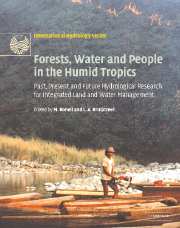 Forests, Water and People in the Humid Tropics
Forests, Water and People in the Humid Tropics Book contents
- Frontmatter
- Contents
- List of contributors
- Foreword
- Preface
- Acknowledgements
- Symposium and Workshop
- Introduction
- Part I Current trends and perspectives on people–land use–water issues
- Part II Hydrological processes in undisturbed forests
- Part III Forest disturbance, conversion and recovery
- Part IV New methods for evaluating effects of land-use change
- Part V Critical appraisals of best management practices
- 35 Guidelines for controlling vegetation, soil and water impacts of timber harvesting in the humid tropics
- 36 Minimising the hydrological impact of forest harvesting in Malaysia's rainforests
- 37 Red flags of warning in land clearing
- 38 From nature to nurture: soil and water management for rainfed steeplands in the humid tropics
- Conclusion: Forests, water and people in the humid tropics: an emerging view
- Plate section
- References
36 - Minimising the hydrological impact of forest harvesting in Malaysia's rainforests
from Part V - Critical appraisals of best management practices
Published online by Cambridge University Press: 12 January 2010
- Frontmatter
- Contents
- List of contributors
- Foreword
- Preface
- Acknowledgements
- Symposium and Workshop
- Introduction
- Part I Current trends and perspectives on people–land use–water issues
- Part II Hydrological processes in undisturbed forests
- Part III Forest disturbance, conversion and recovery
- Part IV New methods for evaluating effects of land-use change
- Part V Critical appraisals of best management practices
- 35 Guidelines for controlling vegetation, soil and water impacts of timber harvesting in the humid tropics
- 36 Minimising the hydrological impact of forest harvesting in Malaysia's rainforests
- 37 Red flags of warning in land clearing
- 38 From nature to nurture: soil and water management for rainfed steeplands in the humid tropics
- Conclusion: Forests, water and people in the humid tropics: an emerging view
- Plate section
- References
Summary
INTRODUCTION
Malaysia has a long experience of forestry management, with the Forestry Department of Peninsular Malaysia being established in 1901. Measures to improve the prospects of natural forest regeneration after the first cut were first applied in 1910, improved in 1927, and again in 1950 with the introduction of the Malayan Uniform System (MUS) and latterly with the application of the Selective Management System (SMS) since the late 1970s (Thang, 1987; Jusoff and Mustafa, 1996; Dawkins and Philip, 1998, p. 154). The guidelines associated with these management systems aim to enhance regeneration in part by limiting collateral damage to trees remaining after the cut. This has the indirect effect of: (a) restricting damage to natural canopies and hence reducing changes to transpiration and wet-canopy evaporation (Asdak, et al., 1998, Chappell, et al., 2001, van Dam, 2001), and (b) requiring more careful skidding or yarding systems, thereby reducing ground damage (Pinard et al., 2000) and hence soil erosion (Douglas et al., 1993; Chappell et al., 1999).
Methods of commercial forestry in Malaysia developed greatly from the mid-1950s onwards, with Malaysian companies now expanding their operations to other tropical countries. Inevitably, with the advancement of forestry technology has come a greater degree of mechanisation, and the potential for greater impact on the physical and biological environment (Wyatt-Smith et al., 1964).
- Type
- Chapter
- Information
- Forests, Water and People in the Humid TropicsPast, Present and Future Hydrological Research for Integrated Land and Water Management, pp. 852 - 865Publisher: Cambridge University PressPrint publication year: 2005
References
- 6
- Cited by


